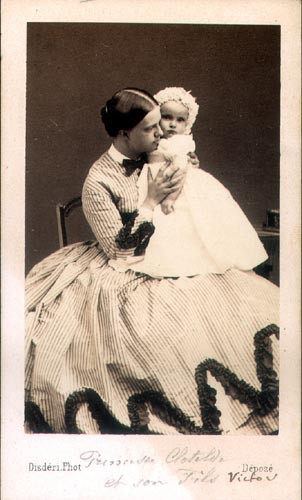A great defender of the “principe des nationalités” (the “nationality principle”, which encompasses the general idea that State and Nation should correspond), Napoleon III threw his support behind the unification process – initiated by the Victor-Emmanuel II, King of Piedmont-Sardinia – which was to take place on the Italian peninsula. This support was given official confirmation following the secret meeting in Plombières, on 21 July, 1858, between Napoleon III and Count Cavour, minister to Victor-Emmanuel II. Most notably, this agreement outlined the incorporation of Savoy into the French Empire in exchange for military assistance against Austria. The participants also agreed on a matrimonial union between the two reigning houses, which would consolidate the alliance between the two states. Cavour successfully convinced Victor Emmanuel II of the necessity of this marriage, which saw the latter’s eldest daughter, Clotilde, and Napoleon III’s cousin, Jerome-Charles Bonaparte (nicknamed “Plon-Plon”) joined in wedlock. Although the Piedmontese king initially considered it a hypogamic union (when the groom is of a socially lower class or status), the marriage was eventually approved and was celebrated on 30 January, 1859, in Turin. Two years later, on 17 March, 1861, Victor-Emmanuel II became King of Italy.
Although the union between the Savoy princess and Bonaparte family member could hardly be considered “happy”, the births of their three children – which included Victor, born on 18 July, 1862 – nevertheless brought great joy to the couple. In this photograph, taken in 1863, Disdéri, one of the great photographers of his time, delivers a family portrait depicting Princess Clotilde and her young son Victor. Clearly enjoying motherhood, Clotilde pulls the child perched on his mother’s knees close to her in a display of great tenderness and love. The photograph positively exudes affection. The tight framing emphasises the contrast between the light-coloured robe and the sombre background, while the floating frill of Clotilde’s dress adds dynamism to the composition.
The young prince, not yet two in this picture, is wearing a white gown and a bonnet, a standard unisex outfit worn by children of the period. Despite his young age, he stares straight at the camera and gives off a serious but captivating air: one could say he’s a real professional! His mastery of the photographic medium remained with him throughout his life, and Victor was to prove an accomplished devotee of this new iconographic invention. Few would have imagined that in 1862, following the death of Napoleon III’s son, “Loulou”, this product of an arranged marriage would become the heir to the imperial throne.
Romain Carvalho (tr. H.D.W.)
April 2011


